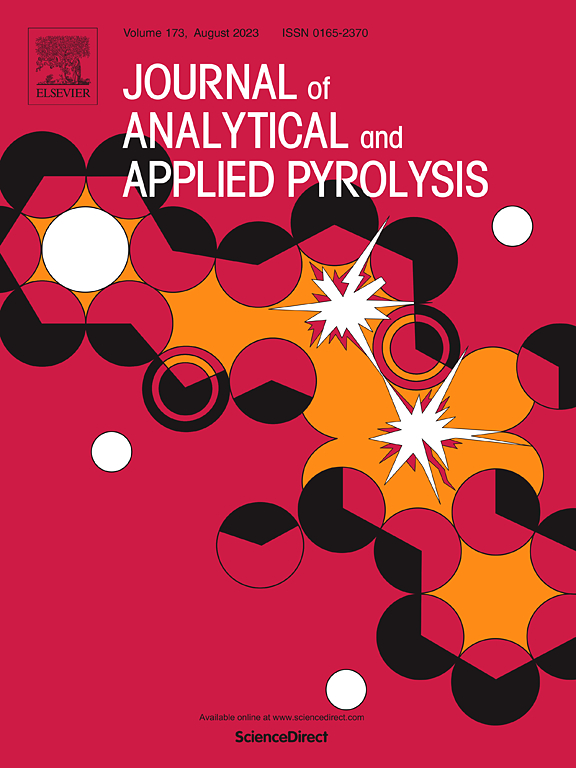通过液态金属催化热解纤维素
IF 6.2
2区 化学
Q1 CHEMISTRY, ANALYTICAL
引用次数: 0
摘要
作为生物质转化的催化介质,液态金属在很大程度上尚未被开发。与容易失活的传统固态催化剂不同,液态金属,即在熔点以上工作的低熔点金属,可以显示出抗结焦性、高导热性以及催化剂与生物质原料之间更强的液固接触性。这一前景促使我们对液态金属作为纤维素热解催化剂进行了研究。铋、锡和铟被选为候选液态金属,并通过热重分析研究了它们对纤维素脱溶动力学的影响。结果表明,这三种金属都具有催化活性,其中铋能催化挥发物的形成,而铟和锡则能促进炭的形成。液态产物的定量分析显示,铋对脱水和功能重排反应具有选择性,从而导致脱水糖和功能化呋喃的形成。与此相反,铟和锡对脱水、破碎反应和 Diels Alder 化学反应具有选择性,导致 C2-C4 片段和芳香族化合物的形成,这一点通过对获得的木炭进行红外光谱分析得到了进一步证实。最后,通过在热重分析仪(TGA)中使用同一批催化剂进行多次纤维素热解,考察了锡和铋液态金属与传统固态沸石催化剂相比在焦化失活方面的稳定性。虽然 ZSM-5 沸石催化剂的活性和选择性有所下降,并在最初几次运行中接近于非催化砂结果(TGA 曲线和液体产物分布),但在进行的耐久性运行中,锡和铋催化剂都保持了较强的抗结焦能力。总之,研究结果表明,这类新型催化剂在生物质热解方面大有可为。本文章由计算机程序翻译,如有差异,请以英文原文为准。
Cellulose pyrolysis via liquid metal catalysis
Liquid metals are largely unexplored as catalytic media for biomass conversion. Unlike conventional solid-state catalysts which are prone to deactivation, liquid metals, i.e., low-melting metals operated above their melting point, can show resilience against coking, high thermal conductivity, and enhanced liquid-solid contact between catalyst and biomass feedstocks. This promise motivated the present investigation of liquid metals as catalysts for cellulose pyrolysis. Bismuth, tin, and indium were selected as liquid metal candidates, and their impact on cellulose devolatilization kinetics is studied via thermogravimetric analysis. The results indicate that all three metals show catalytic activity, with bismuth catalyzing volatiles formation, while indium and tin enhance char formation. Quantitative analysis of liquid product reveals that bismuth is selective to dehydration and functional rearrangement reactions, leading to anhydro sugars and functionalized furans formation. In contrast, indium and tin are selective towards dehydration, fragmentation reactions, and Diels Alder chemistry, leading to formation of C2-C4 fragments and aromatic compounds, as further confirmed via infrared spectroscopic analysis of the obtained chars. Finally, the Sn and Bi liquid metals’ stability against deactivation via coking is examined against conventional solid-state zeolite catalyst through multiple cellulose pyrolysis runs in the thermogravimetric analyzer (TGA) with the same batch of catalyst. While ZSM-5 zeolite catalyst's activity and selectivity declined and approached non-catalytic sand results (both the TGA curve and the liquid product distribution) within the first few runs, both Sn and Bi fairly maintained their robustness against coking for the conducted durability runs. Overall, the results show significant promise for this new class of catalysts for biomass pyrolysis.
求助全文
通过发布文献求助,成功后即可免费获取论文全文。
去求助
来源期刊
CiteScore
9.10
自引率
11.70%
发文量
340
审稿时长
44 days
期刊介绍:
The Journal of Analytical and Applied Pyrolysis (JAAP) is devoted to the publication of papers dealing with innovative applications of pyrolysis processes, the characterization of products related to pyrolysis reactions, and investigations of reaction mechanism. To be considered by JAAP, a manuscript should present significant progress in these topics. The novelty must be satisfactorily argued in the cover letter. A manuscript with a cover letter to the editor not addressing the novelty is likely to be rejected without review.

 求助内容:
求助内容: 应助结果提醒方式:
应助结果提醒方式:


